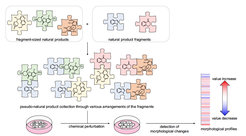Natural product fragment combination to performance-diverse pseudo-natural products
Grigalunas M, Burhop A, Zinken S, Pahl A, Gally JM, Wild N, Mantel Y, Sievers S, Foley DJ, Scheel R, Strohmann C, Antonchick AP, Waldmann H (2021) Nat Commun.
Source
Natural product structure and fragment-based compound development inspire pseudo-natural product design through different combinations of a given natural product fragment set to compound classes expected to be chemically and biologically diverse. We describe the synthetic combination of the fragment-sized natural products quinine, quinidine, sinomenine, and griseofulvin with chromanone or indole-containing fragments to provide a 244-member pseudo-natural product collection. Cheminformatic analyses reveal that the resulting eight pseudo-natural product classes are chemically diverse and share both drug- and natural product-like properties. Unbiased biological evaluation by cell painting demonstrates that bioactivity of pseudo-natural products, guiding natural products, and fragments differ and that combination of different fragments dominates establishment of unique bioactivity. Identification of phenotypic fragment dominance enables design of compound classes with correctly predicted bioactivity. The results demonstrate that fusion of natural product fragments in different combinations and arrangements can provide chemically and biologically diverse pseudo-natural product classes for wider exploration of biologically relevant chemical space.

Overview of the design, combination, and biological evaluation of the pseudo-natural product collection. Fragment-sized natural products were combined with natural product fragments to generate a collection of 244 pseudo-natural products. The compounds were biologically evaluated by the cell painting assay and compared.
